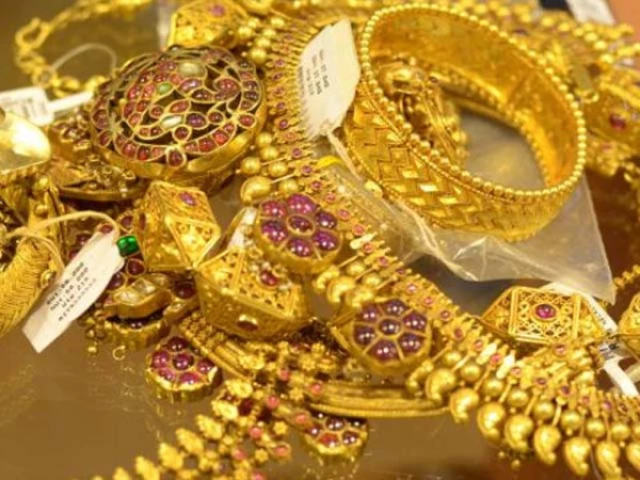Business
Gold prices in Pakistan Today – October 02, 2025 | The Express Tribune

After four consecutive sessions of gains, gold prices retreated in both the international and domestic markets on Thursday.
In the international bullion market, the yellow metal slipped by $25 per ounce to settle at $3,865.
Read: Gold tops Rs400,000 amid global rush
Tracking the global trend, domestic prices also registered a decline. The per tola rate fell by Rs2,500 to Rs407,778, while 10 grams dropped Rs2,144 to Rs349,603.
Silver followed the same trajectory, with per tola prices down Rs13 to Rs4,839 and 10 grams lower by Rs11 at Rs4,148.
Spot gold, however, recovered 0.5% to $3,883.69 per ounce in late trade, down from Wednesday’s all-time high of $3,895.09. US gold futures for December delivery inched up 0.3% to $3,908.90.
Business
Forbes makes plea to UK Government after closure plans for ‘cornerstone’ plant

The Scottish Government has pledged it will “explore all options” to support ExxonMobil workers in Fife, after the energy giant announced it is to close its plant at Mossmorran.
But Scotland’s Deputy First Minister Kate Forbes said it was also “crucial” that Labour ministers at Westminster “consider what more they can do for the workers at the plant and take urgent action”.
She spoke out at Holyrood hours after ExxonMobil announced its ethylene manufacturing plant, which produces the base material for many plastics, is expected to close in February.
The move puts 179 workers directly employed at Mossmorran at risk, along with the jobs of 250 contractors – although there is the possibility of 50 staff transferring to the Fawley Petrochemical Complex almost 500 miles away in Hampshire.
In a statement, ExxonMobil said its Fife Ethylene Plant “has been a cornerstone of chemical production in the UK for 40 years”,
However, the firm added that the closure “reflects the challenges of operating in a policy environment that is accelerating the exit of vital industries, domestic manufacturing, and the high-value jobs they provide”.
ExxonMobil said: “We considered various options to continue production and tested the market for a potential buyer, but the UK’s current economic and policy environment combined with market conditions, high supply costs and plant efficiency do not create a competitive future for the site.”
Ms Forbes said she was “extremely disappointed” by the move.
Speaking at Holyrood, she said: “I wish to provide my assurance to the workforce that we will work with them and their representatives to explore all options to support them.”
She pledged the Scottish Government would now “engage constructively” with Fife Council and others to “consider all possible actions to mitigate any impact on the local economy”.
Ms Forbes also promised to convene a taskforce “to urgently consider any actions the Scottish Government, with the limited economic powers we have, could take to mitigate the impact of this decision”.
With the planned closure coming after the oil refinery at Grangemouth was shut down in April this year, the Deputy First Minister also said work to find an alternative future for this site would be expanded to include Mossmorran.
But she said the UK Government must work with her to “secure a future for the site”.
Ms Forbes said: “ExxonMobil has been clear in its announcement today that the UK’s current economic and policy environment does not create a competitive future for its site.”
Stressing that the “levers for an industrial intervention” lie with Westminster, she added: “I believe it is crucial that UK ministers consider what more they can do for the workers at the plant and take urgent action – overdue action – to address the high cost of energy which is slowly crippling industry.”
Scottish Secretary Douglas Alexander, however, said that the closure decision was “ultimately a commercial one” for the company.
“This is an incredibly difficult time for the Mossmorran workers and their families,” Mr Alexander said.
“The UK Government has explored every reasonable avenue to support the site, but the closure decision is ultimately a commercial one for Exxon, a company which is facing significant global challenges.
“Our focus now must be on supporting the workforce in the months ahead.”
Sharon Graham, the general secretary of the trade union Unite, said it was “utterly disgraceful” that the company had decided to shutter the plant.
“ExxonMobil must withdraw the closure threat and enter into meaningful negotiations with all key players to ensure the future of the plant and jobs,” she demanded.
The union’s industrial officer, Bob MacGregor, added: “Today’s news is devastating for the workers at the plant and the local community as well as the industry as a whole. Unite will do everything it can to support our members through the next few weeks.
“ExxonMobil is one of the richest companies in the world. It cannot be allowed to walk away and leave an industrial wasteland in Fife.”
Robert Deavy, a senior organiser for trade union GMB, which represents contractors on the site, called for politicians to put together a “planned and measured” transition.
“This is more grim news for workers, their families and communities but exactly how much more bad news is needed before ministers protect jobs and our country’s energy security? How many dominoes have to fall?
“Our members do not need more politicians wringing their hands or making more speeches promising just transitions. There is nothing just about what is going on and there is no transition.
“We need politicians willing to finally stand up and demand an industrial strategy that protects the UK’s crucial oil and gas while actually delivering a planned and measured transition instead of the economic carnage unfolding day by day.”
Business
Don’t blindly trust what AI tells you, Google boss tells BBC

Faisal Islam,economics editor,
Rachel Clun,business reporter and
Liv McMahon,Technology reporter
 Getty Images
Getty ImagesPeople should not “blindly trust” everything AI tools tell them, the boss of Google’s parent company Alphabet has told the BBC.
In an exclusive interview, chief executive Sundar Pichai said that AI models are “prone to errors” and urged people to use them alongside other tools.
Mr Pichai said it highlighted the importance of having a rich information ecosystem, rather than solely relying on AI technology.
“This is why people also use Google search, and we have other products that are more grounded in providing accurate information.”
However, some experts say big tech firms such as Google should not be inviting users to fact-check their tools’ output, but should focus instead on making their systems more reliable.
While AI tools were helpful “if you want to creatively write something”, Mr Pichai said people “have to learn to use these tools for what they’re good at, and not blindly trust everything they say”.
He told the BBC: “We take pride in the amount of work we put in to give us as accurate information as possible, but the current state-of-the-art AI technology is prone to some errors.”
The company displays disclaimers on its AI tools to let users know they can make mistakes.
But this has not shielded it from criticism and concerns over errors made by its own products.
Google’s rollout of AI Overviews summarising its search results was marred by criticism and mockery over some erratic, inaccurate responses.
The tendency for generative AI products, such as chatbots, to relay misleading or false information, is a cause of concern among experts.
“We know these systems make up answers, and they make up answers to please us – and that’s a problem,” Gina Neff, professor of responsible AI at Queen Mary University of London, told BBC Radio 4’s Today programme.
“It’s okay if I’m asking ‘what movie should I see next’, it’s quite different if I’m asking really sensitive questions about my health, mental wellbeing, about science, about news,” she said.
She also urged Google to take more responsibility over its AI products and their accuracy, rather than passing that on to consumers.
“The company now is asking to mark their own exam paper while they’re burning down the school,” the said.
‘A new phase’
The tech world has been awaiting the latest launch of Google’s consumer AI model, Gemini 3.0, which is starting to win back market share from ChatGPT.
The company unveiled the model on Tuesday, claiming it would unleash “a new era of intelligence” at the heart of its own products such as its search engine.
In a blog post, it said Gemini 3 boasted industry-leading performance across understanding and responding to different modes of input, such as photo, audio and video, as well as “state-of-the-art” reasoning capabilities.
In May this year, Google began introducing a new “AI Mode” into its search, integrating its Gemini chatbot which is aimed at giving users the experience of talking to an expert.
At the time, Mr Pichai said the integration of Gemini with search signalled a “new phase of the AI platform shift”.
The move is also part of the tech giant’s bid to remain competitive against AI services such as ChatGPT, which have threatened Google’s online search dominance.
His comments back up BBC research from earlier this year, which found that AI chatbots inaccurately summarised news stories.
OpenAI’s ChatGPT, Microsoft’s Copilot, Google’s Gemini and Perplexity AI were all given content from the BBC website and asked questions about it, and the research found the AI answers contained “significant inaccuracies“.
Broader BBC findings have since suggested that, despite improvements, AI assistants still misrepresent news 45% of the time.
In his interview with the BBC, Mr Pichai said there was some tension between how fast technology was being developed and how mitigations are built in to prevent potential harmful effects.
For Alphabet, Mr Pichai said managing that tension means being “bold and responsible at the same time”.
“So we are moving fast through this moment. I think our consumers are demanding it,” he said.
The tech giant has also increased its investment in AI security in proportion with its investment in AI, Mr Pichai added.
“For example, we are open-sourcing technology which will allow you to detect whether an image is generated by AI,” he said.
Asked about recently uncovered years-old comments from tech billionaire Elon Musk to OpenAI’s founders around fears the now Google-owned DeepMind could create an AI “dictatorship”, Mr Pichai said “no one company should own a technology as powerful as AI”.
But he added there were many companies in the AI ecosystem today.
“If there was only one company which was building AI technology and everyone else had to use it, I would be concerned about that too, but we are so far from that scenario right now,” he said.
Business
Cloud infra deal: Microsoft partners with Anthropic and Nvidia; $45 billion cloud deal to reshape AI infrastructure – The Times of India

Microsoft on Tuesday announced a sweeping cloud infrastructure partnership with artificial intelligence firm Anthropic and chipmaker Nvidia, marking a significant realignment in the technology giant’s AI alliances as it moves further away from exclusive dependence on OpenAI, AP reported.Anthropic, the developer of rival chatbot Claude, said it will commit to purchasing $30 billion worth of computing capacity from Microsoft’s Azure cloud platform under the new agreement. As part of the same partnership, Nvidia will invest up to $10 billion in Anthropic, while Microsoft will invest up to $5 billion in the San Francisco-based company.The joint announcement from Anthropic CEO Dario Amodei, Microsoft CEO Satya Nadella and Nvidia CEO Jensen Huang was made just before the opening of Microsoft’s annual Ignite developer conference.Microsoft had long served as OpenAI’s exclusive cloud provider, but that arrangement began to shift earlier this year. While the two companies continue to collaborate, OpenAI has expanded its cloud strategy by striking major deals with Oracle, SoftBank and other chipmakers and data-centre operators to secure additional computing capacity.The latest move strengthens Microsoft’s position in the rapidly intensifying AI infrastructure race and gives Anthropic access to one of the world’s largest cloud ecosystems as competition with OpenAI accelerates.
-

 Tech1 week ago
Tech1 week agoFrom waste to asset: Turning ethanol production CO₂ into jet fuel
-

 Tech3 days ago
Tech3 days agoNew carbon capture method uses water and pressure to remove CO₂ from emissions at half current costs
-

 Politics5 days ago
Politics5 days agoBritish-Pakistani honoured for transforming UK halal meat industry
-

 Sports3 days ago
Sports3 days agoTexas A&M officer scolds South Carolina wide receiver after touchdown; department speaks out
-

 Business3 days ago
Business3 days agoThese 9 Common Money Mistakes Are Eating Your Income
-

 Tech1 week ago
Tech1 week agoSecurity flaws in portable genetic sequencers risk leaking private DNA data
-

 Fashion6 days ago
Fashion6 days agoAdidas & Patrick Mahomes expand NIL programme with Texas Tech athletes
-

 Business4 days ago
Business4 days agoWhat’s behind Rachel Reeves’s hokey cokey on income tax rises?












